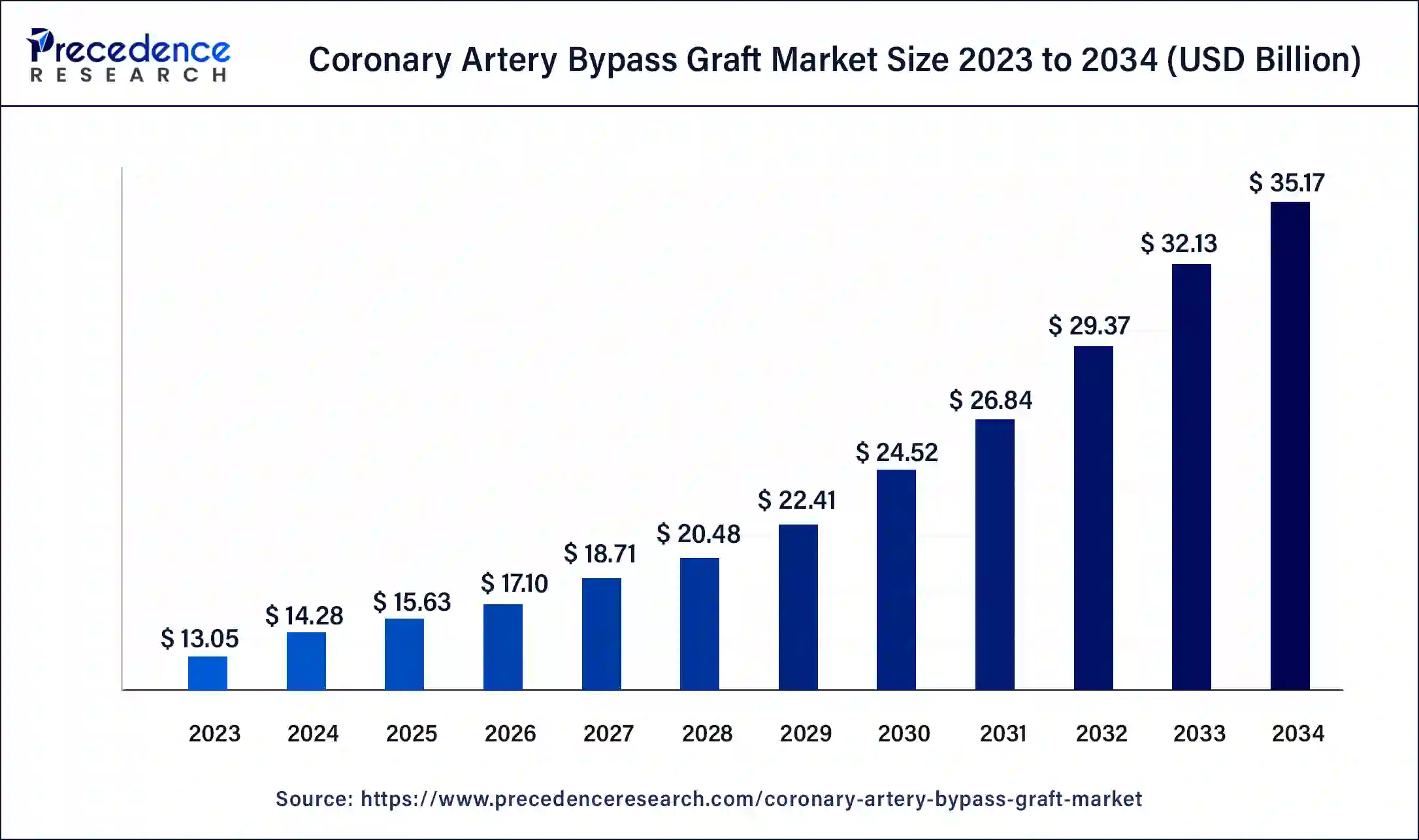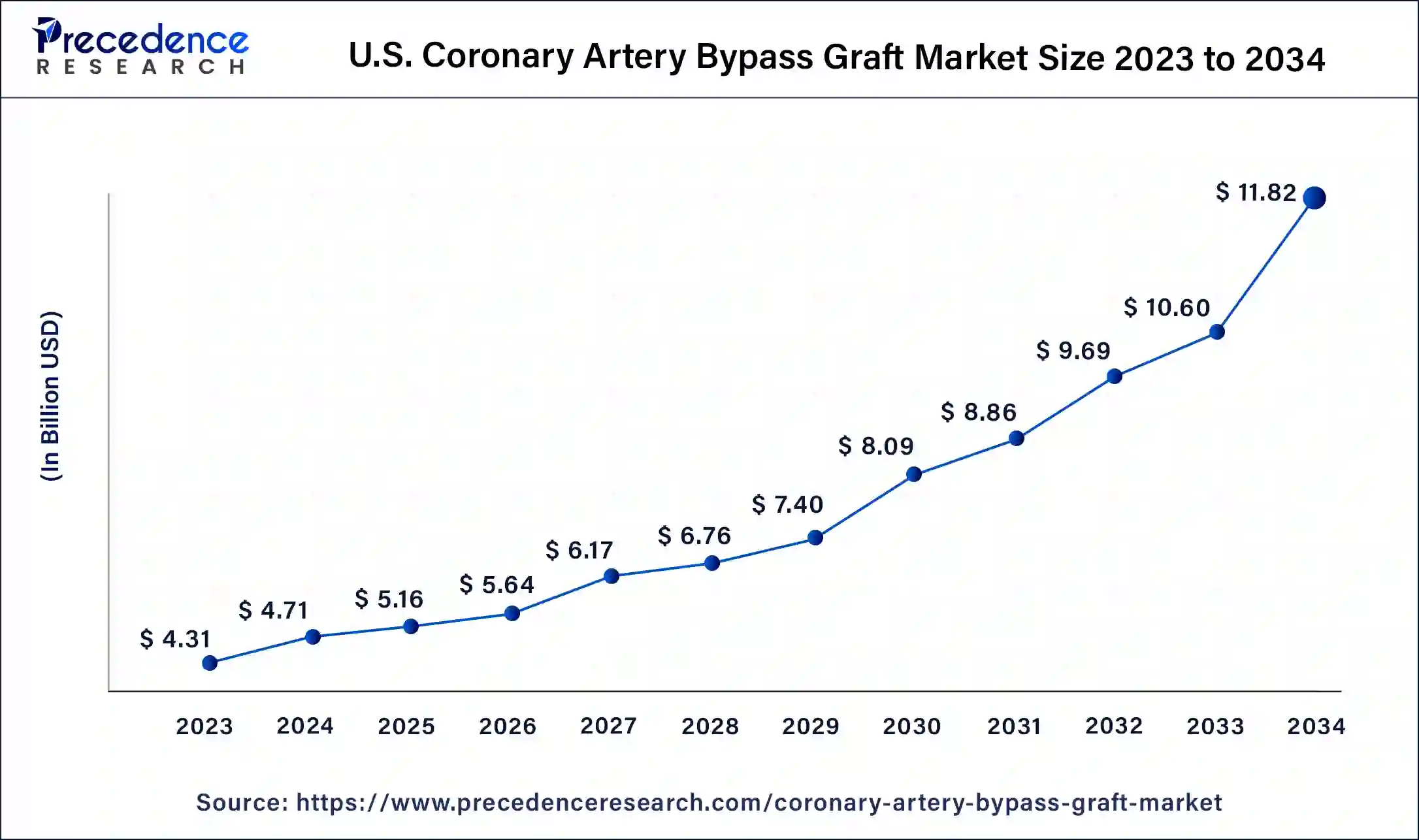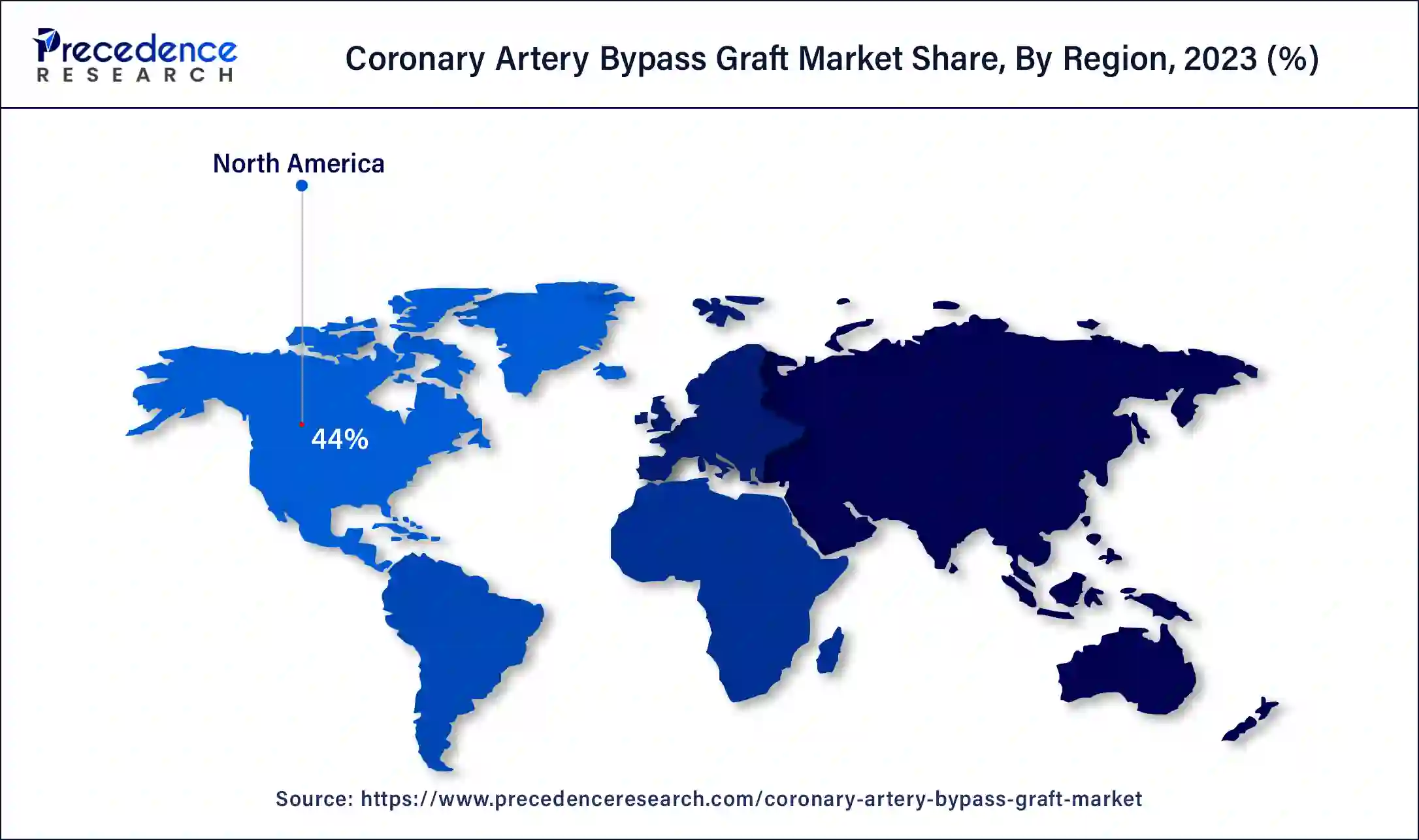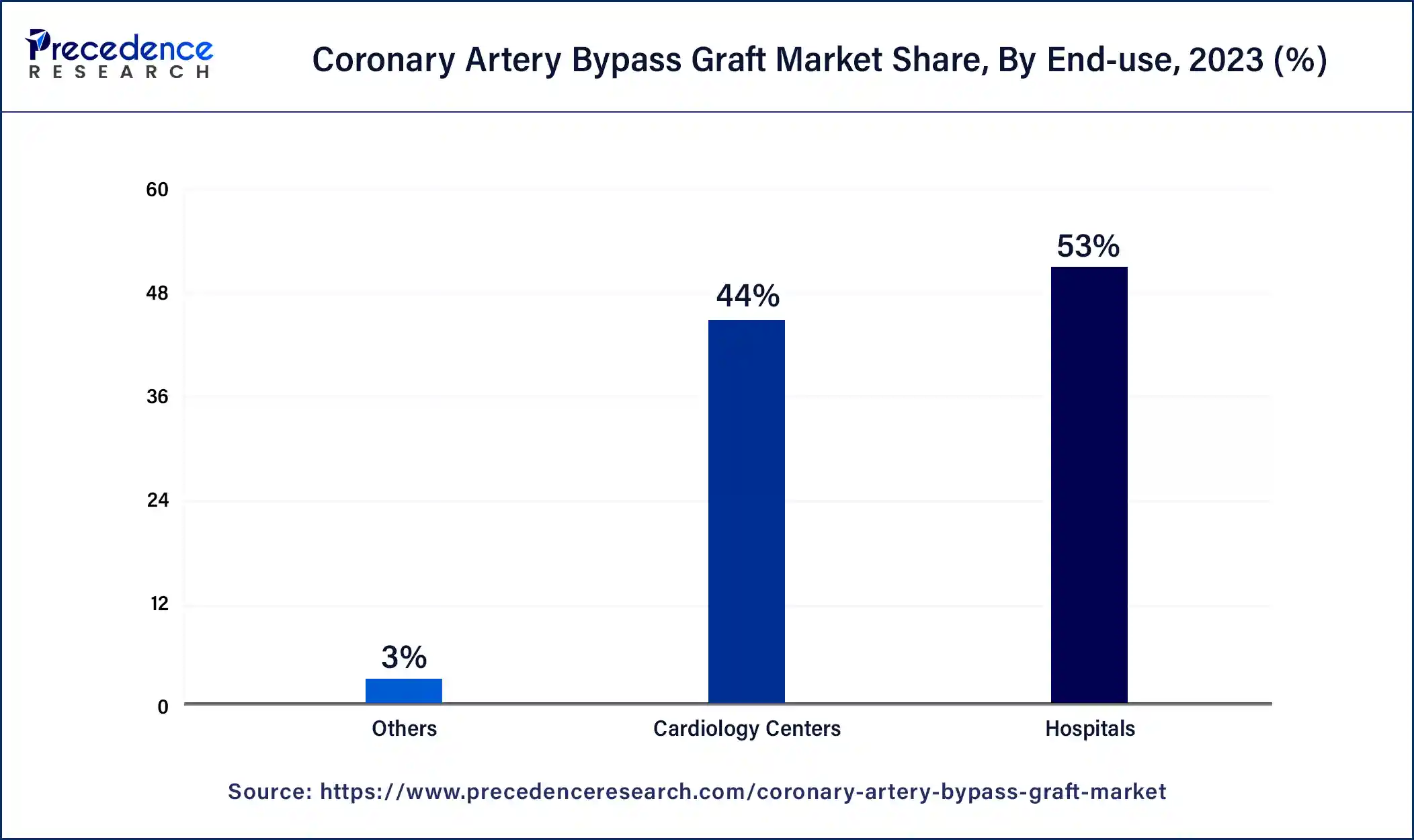August 2024
The global coronary artery bypass graft market size surpassed USD 13.05 billion in 2023 and is estimated to increase from USD 14.28 billion in 2024 to approximately USD 35.17 billion by 2034. It is projected to grow at a CAGR of 9.43% from 2024 to 2034.
The global coronary artery bypass graft market size is projected to be worth around USD 35.17 billion by 2034 from USD 14.28 billion in 2024, at a CAGR of 9.43% from 2024 to 2034. The need for the coronary artery bypass graft market is driven by the rise in cardiovascular illnesses worldwide, which frequently necessitate surgical intervention.

U.S. Coronary Artery Bypass Graft Market Size and Growth 2024 to 2034
The U.S. coronary artery bypass graft market size was exhibited at USD 4.31 billion in 2023 and is projected to be worth around USD 11.82 billion by 2034, poised to grow at a CAGR of 9.60% from 2024 to 2034.

North America held the largest share of the coronary artery bypass graft market in 2023. The need for CABG treatments is fueled by the increased incidence of cardiovascular illnesses, which are caused by conditions including obesity, diabetes, and high blood pressure. The prevalence of coronary artery disease is rising in North America due to the aging population, which in turn is driving up demand for CABG treatments. Government and private insurers' coverage and reimbursement practices have a big influence on the market.
Access to CABG treatments is facilitated in part by government support for heart disease treatment and comprehensive insurance plans. The effectiveness of CABG treatments is being improved by advancements in imaging technologies, surgical equipment, and new graft materials, including biological and synthetic choices. The market is growing in part because of rising public knowledge and education on cardiac disease and the advantages of CABG treatment.

Asia Pacific is set to host the fastest-growing coronary artery bypass graft market over the forecast period. One important factor is the increasing incidence of cardiovascular illnesses, such as coronary artery disease. This trend is influenced by variables like aging populations, changing lifestyles, and rising rates of hypertension and diabetes. The efficiency and security of CABG surgeries are being enhanced by advances in surgical methods and technology, including less intrusive approaches and better graft materials.
Enhancements in the healthcare infrastructure and rising healthcare expenditures in numerous Asia Pacific nations are making advanced therapies, such as CABG procedures, more accessible. The need for CABG is rising as a result of improved cardiovascular health awareness and the development of diagnostic techniques that enable early identification and treatment of coronary artery disorders.
Products and services linked to surgical treatments intended to treat coronary artery disease (CAD) by enhancing heart blood flow are included in coronary artery bypass graft (CABG). The increasing global prevalence of coronary artery disease makes the coronary artery bypass graft market substantial. It is anticipated to increase gradually as the need for CABG procedures is driven by an aging population and a rising prevalence of risk factors.
Market growth is attributed to factors such as an aging population, an increase in the prevalence of coronary artery disease, technological breakthroughs in surgical methods, and enhanced healthcare infrastructure. The market's growth may be impacted by the high cost of surgery, the possibility of complications, and competition from non-surgical treatments like percutaneous coronary interventions (PCI).
In order to improve results and shorten recovery times, research is always being conducted on graft materials, surgical procedures, and the integration of new technology, such as robotic surgery. The CABG methods are changing due to the integration of robotics and minimally invasive techniques, which may lead to shorter recovery times and better patient results. Improving pre-and post-operative care, as well as personalized medicine, are increasingly crucial for raising the success rates of CABG procedures.
The market for CABG is anticipated to expand steadily overall due to rising rates of cardiovascular disease and improvements in surgical methods. A developing market where healthcare spending is rising and the incidence of coronary heart disease is rising. India and China are two nations where the number of CABG procedures is rapidly increasing.
How AI is Implemented for Cardiac Surgeries?
The role of artificial intelligence is observed to sustain over the period in overall healthcare sector. Among which the application of AI in cardiac surgeries is seen to leverage. AI has stepped as a major tool to potentially boost the efficacy of cardiac surgery necessities as it has the capability to judge or detect risk assessment, prognostication and stratification. Machine learning also leverages efficiency of post-operative complications. Multiple studies have revealed that AI implementation has immensely helped healthcare providers in decision making processes such as provision of healthcare support post surgeries, real-life clinical setting and image interpretation of clinical risk assessment.
| Report Coverage | Details |
| Market Size by 2034 | USD 35.17 Billion |
| Market Size in 2023 | USD 13.05 Billion |
| Market Size in 2024 | USD 14.28 Billion |
| Market Growth Rate from 2024 to 2034 | CAGR of 9.43% |
| Largest Market | North America |
| Base Year | 2023 |
| Forecast Period | 2024 to 2034 |
| Segments Covered | Method, Surgical Procedure, End use, and Regions |
| Regions Covered | North America, Europe, Asia-Pacific, Latin America and Middle East & Africa |
Improved healthcare infrastructure
Early identification of coronary artery disease is now possible thanks to advancements in diagnostic tools and imaging technologies, such as high-resolution MRI and CT scanners. This results in more people being evaluated for CABG procedures and prompt intervention. Better post-operative care for CABG patients is ensured by upgraded ICU and recovery room facilities, which shortens recovery times and improves overall results.
This covers specialist cardiac care units and cutting-edge monitoring devices. Upgrades to the physical therapy and lifestyle modification programs offered at cardiac rehabilitation facilities give patients individualized rehabilitation plans that are essential for the coronary artery bypass graft market. Better patient care results from improved healthcare infrastructure, which enables continuing education and training for medical staff and keeps them up to date on the newest CABG methods and innovations.
Patient compliance and lifestyle factors
Individuals who take their prescription drugs as directed (statins, antiplatelet medications, etc.) are at lower risk of side effects or graft failure. Improved long-term results from high compliance rates may lessen the need for follow-up procedures and impact consumer demand. Smoking can have an impact on graft health and is a significant risk factor for cardiovascular disease. Following CABG, patients who give up smoking or refrain from smoking are more likely to experience better results, which may have an impact on general market trends. The coronary artery bypass graft market can be influenced by lower total healthcare expenditures resulting from improved patient outcomes achieved via compliance and healthy lifestyles.
Focus on personalized medicine
Genetic and biomarker analysis are used in personalized medicine to identify patient-specific hazards and forecast treatment outcomes. This can aid in anticipating possible issues and choosing the best graft material and surgical methods. In the coronary artery bypass graft market, better risk stratification is made possible by personalized medicine, which can identify individuals who may be more susceptible to problems or transplant failure. Individualized treatment plans can lead to improved surgical outcomes, such as lower graft failure rates, fewer complications, and quicker recovery periods. Personalized medicine can result in cost savings over time by lowering problems and hospital readmissions, even if it may initially cost more due to enhanced diagnostic testing and customized therapies.
The off-pump segment dominated the coronary artery bypass graft market in 2023. In the coronary artery bypass graft market, procedures carried out without the use of a heart-lung machine which customarily assumes control of the patient's heart during the procedure are referred to as off-pump procedures. The surgeon does surgery on the beating heart instead. Growth in the off-pump CABG sector is being driven by advances in surgical instruments and techniques that make off-pump treatments more practical as more surgeons and healthcare facilities adopt this technique. Growing patient preference for less intrusive procedures and better results also has an impact on this segment's growth. In contrast to typical on-pump CABG, patients frequently have a quicker recovery and less postoperative inflammation.
The on-pump segment is expected to grow at the fastest rate in the coronary artery bypass graft market over the study period. The term ‘on-pump’ describes surgical procedures in which a heart-lung machine assumes the role of the patient's heart and lungs. By using this method, surgeons can do operations on a heart that is still and bloodless, which can enhance accuracy and results.
A steady surgical environment is made possible by on-pump CABG, which lowers the possibility of partial revascularization and enables more accurate graft placement. Though this can vary depending on patient characteristics and surgeon experience, some studies suggest that on-pump CABG can be associated with reduced rates of graft failure and better long-term outcomes compared to off-pump surgeries. Advancements are continuously improving the safety and effectiveness of on-pump CABG procedures in heart-lung devices and associated technology.
The single CABG surgery segment dominated the coronary artery bypass graft market in 2023. Within the coronary artery bypass graft market, the single CABG surgery sector describes the process of bypassing a single blocked coronary artery using a single artery or vein. This market category is a subset of the larger CABG market, which also covers a range of surgical methods and strategies for enhancing cardiac blood flow.
It involves employing a graft, usually obtained from the patient's own body (such as the internal mammary artery or the saphenous vein from the leg), to bypass a single obstructed artery. In certain clinical situations, a single CABG technique might be selected, which could have an effect on the market share of several CABG kinds. Patient decisions and market dynamics are impacted by potential problems and recovery timeframes.
The double CABG surgery segment is expected to grow at the fastest rate in the coronary artery bypass graft market over the study period. Due to the rise in cardiovascular illnesses and improvements in surgical procedures, the double CABG segment is expanding. This rise is attributed to both the aging population and the increasing incidence of coronary artery disease. It is common for people with two blocked coronary arteries to benefit from double CABG surgery.
When compared to alternative therapies, this operation can greatly enhance quality of life and heart function. The market includes a range of companies, from makers of medical devices to providers of healthcare services, that offer specific goods and technologies for double CABG procedures. Approvals and regulations from the government are very important in forming the market. Surgical operations are safe and effective when standards and rules are followed.
The hospital segment dominated the coronary artery bypass graft market in 2023. Hospitals are doing more CABG procedures as the prevalence of coronary artery disease increases. In areas where cardiovascular disease rates are high, this trend is especially noticeable. The effectiveness and safety of these surgeries are being improved by advances in surgical instruments and technology, as well as new surgical techniques such as minimally invasive CABG treatments.
As a result, hospitals are adopting these procedures more frequently. The growth of the CABG market is probably going to be driven by hospitals that have specialized cardiovascular departments and advanced cardiac care units. Modern infrastructure and equipment purchases help to sustain this trend. An increasing number of hospitals are implementing CABG operations due to better patient outcomes and faster recovery times made possible by new technologies and techniques.

The cardiology centers segment is expected to grow at the fastest rate in the coronary artery bypass graft market over the study period. The rising incidence of coronary artery disease and improvements in surgical methods and technology are driving the expansion of cardiology facilities in the CABG industry. The development of cardiology centers is facilitated by advancements in graft materials, imaging technologies, and surgical techniques such as less invasive CABG operations.
The capacity of cardiology centers to perform CABG procedures is improved by their growth and modernization, which includes the adoption of cutting-edge diagnostic and therapeutic technology. Region-to-region variations exist in the expansion and prevalence of cardiology centers; industrialized countries tend to have more sophisticated facilities than emerging economies. A combination of private practices, specialized cardiac facilities, and sizable hospital networks within this segment influences the market dynamics.
Segment Covered in the Report
By Method
By Surgical Procedure
By End use
By Geography
For inquiries regarding discounts, bulk purchases, or customization requests, please contact us at sales@precedenceresearch.com
No cookie-cutter, only authentic analysis – take the 1st step to become a Precedence Research client
August 2024
July 2024
June 2024
July 2024